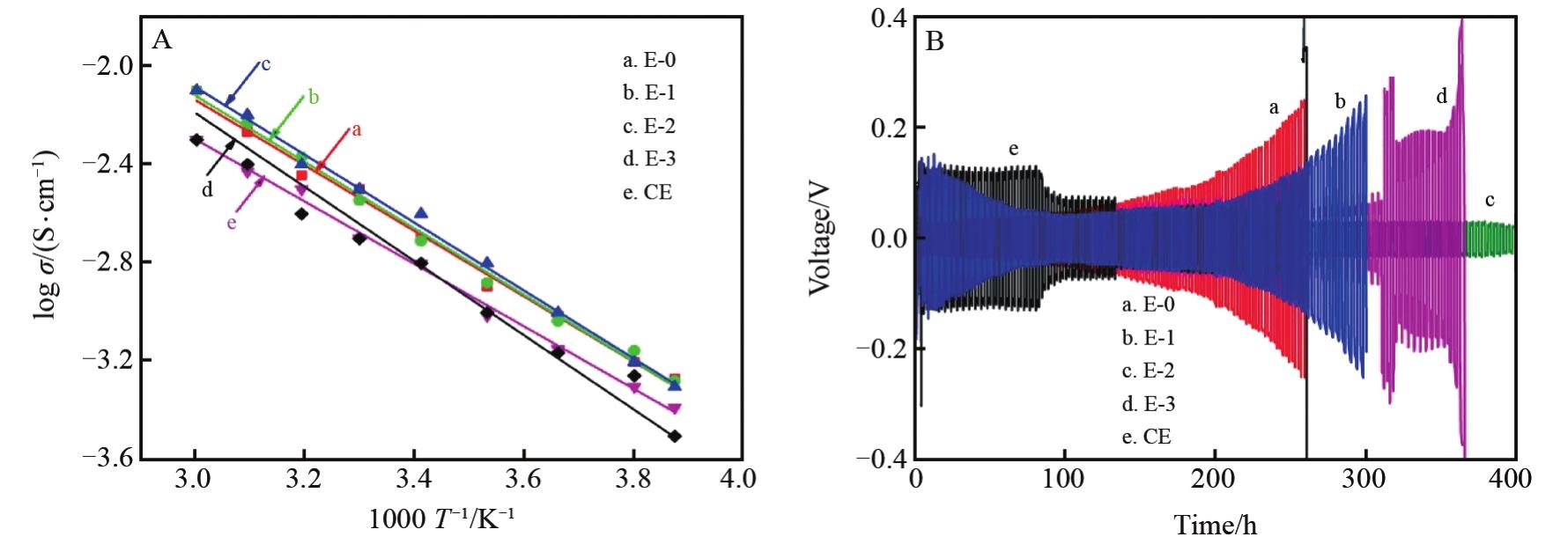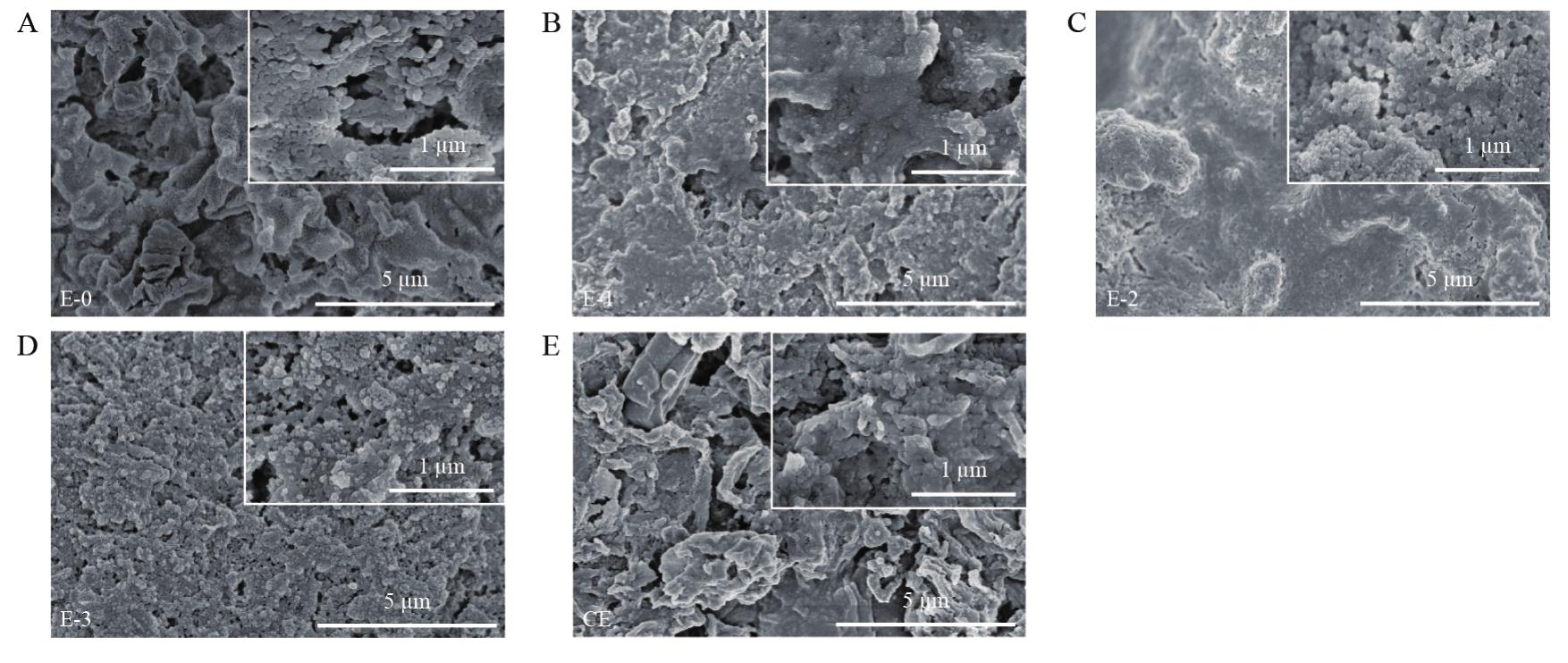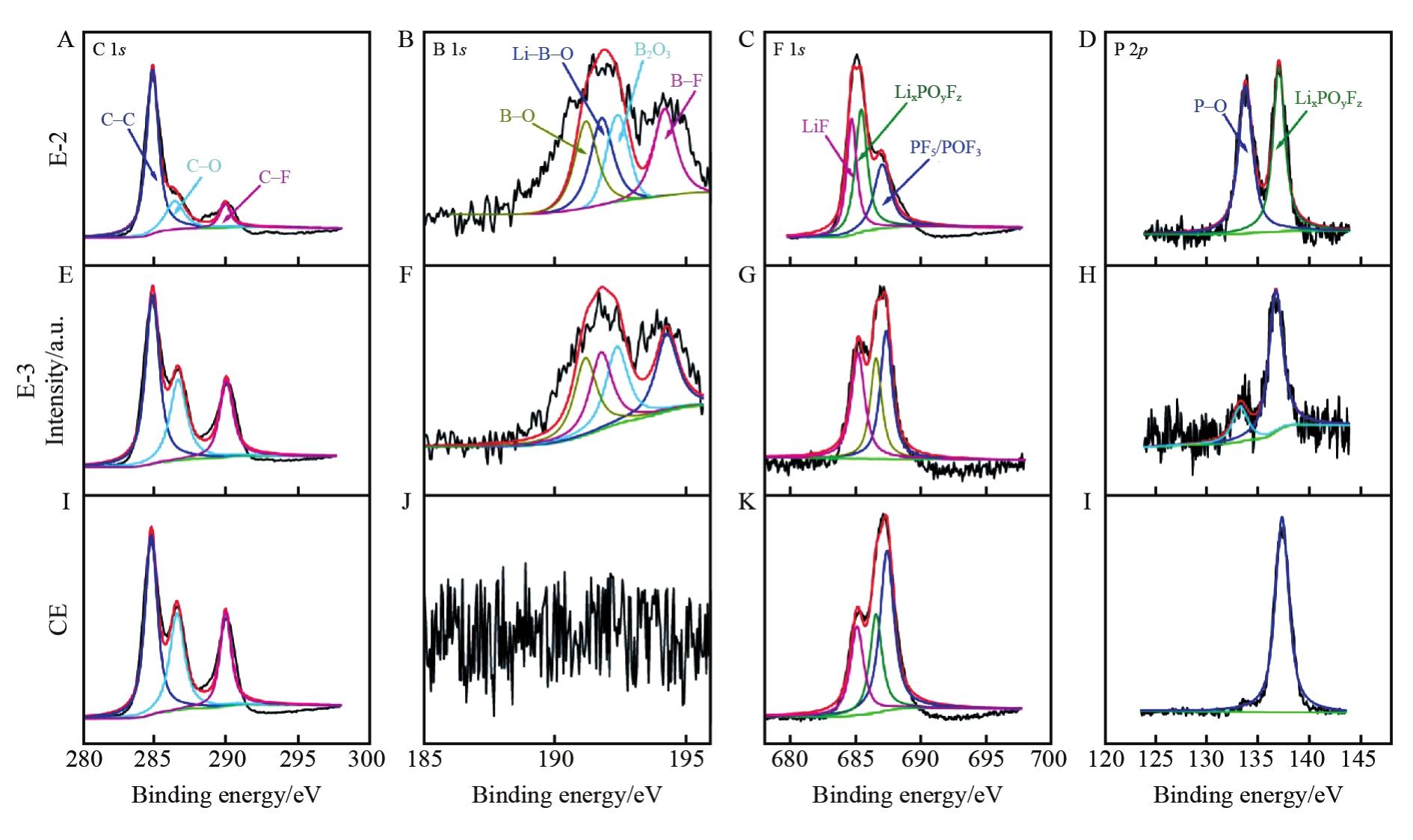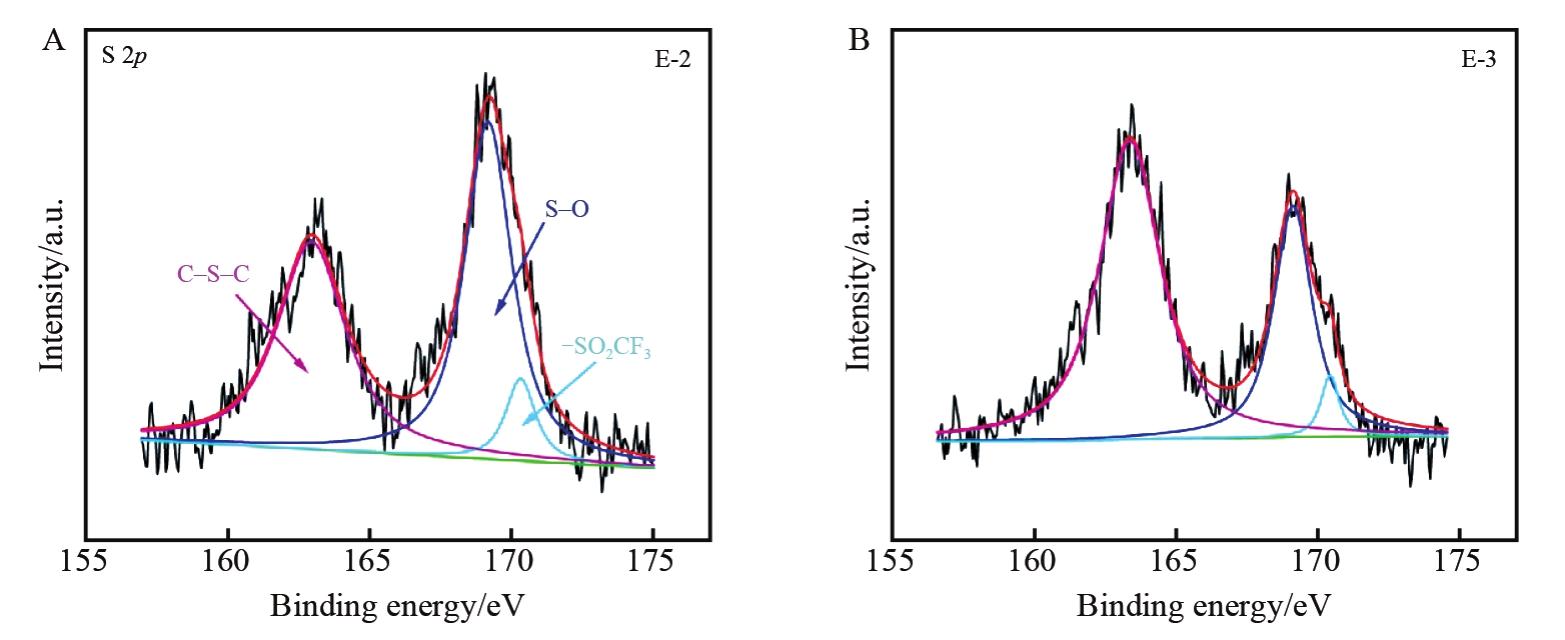
Chinese Journal of Applied Chemistry ›› 2022, Vol. 39 ›› Issue (02): 298-306.DOI: 10.19894/j.issn.1000-0518.210090
• Full Papers • Previous Articles Next Articles
Electrochemical Performance of Lithiophilic Electrolyte in LiNi0.6Mn0.2Co0.2O2/Li Rechargeable Lithium Metal Battery
Du-Bin HUANG1,3( ), Pei-Min WANG2, Jin-Long WU3
), Pei-Min WANG2, Jin-Long WU3
- 1.Zhejiang Gold Feather New Energy Technology Co. , Ltd. , Huzhou 313300, China
2.Geely University of China, Beijing 102202, China
3.Beijing Gold Feather New Energy Technology Co. , Ltd. , Beijing 100015, China
-
Received:2021-03-02Accepted:2021-06-25Published:2022-02-10Online:2022-02-09 -
Contact:Du-Bin HUANG
CLC Number:
Cite this article
Du-Bin HUANG, Pei-Min WANG, Jin-Long WU. Electrochemical Performance of Lithiophilic Electrolyte in LiNi0.6Mn0.2Co0.2O2/Li Rechargeable Lithium Metal Battery[J]. Chinese Journal of Applied Chemistry, 2022, 39(02): 298-306.
share this article
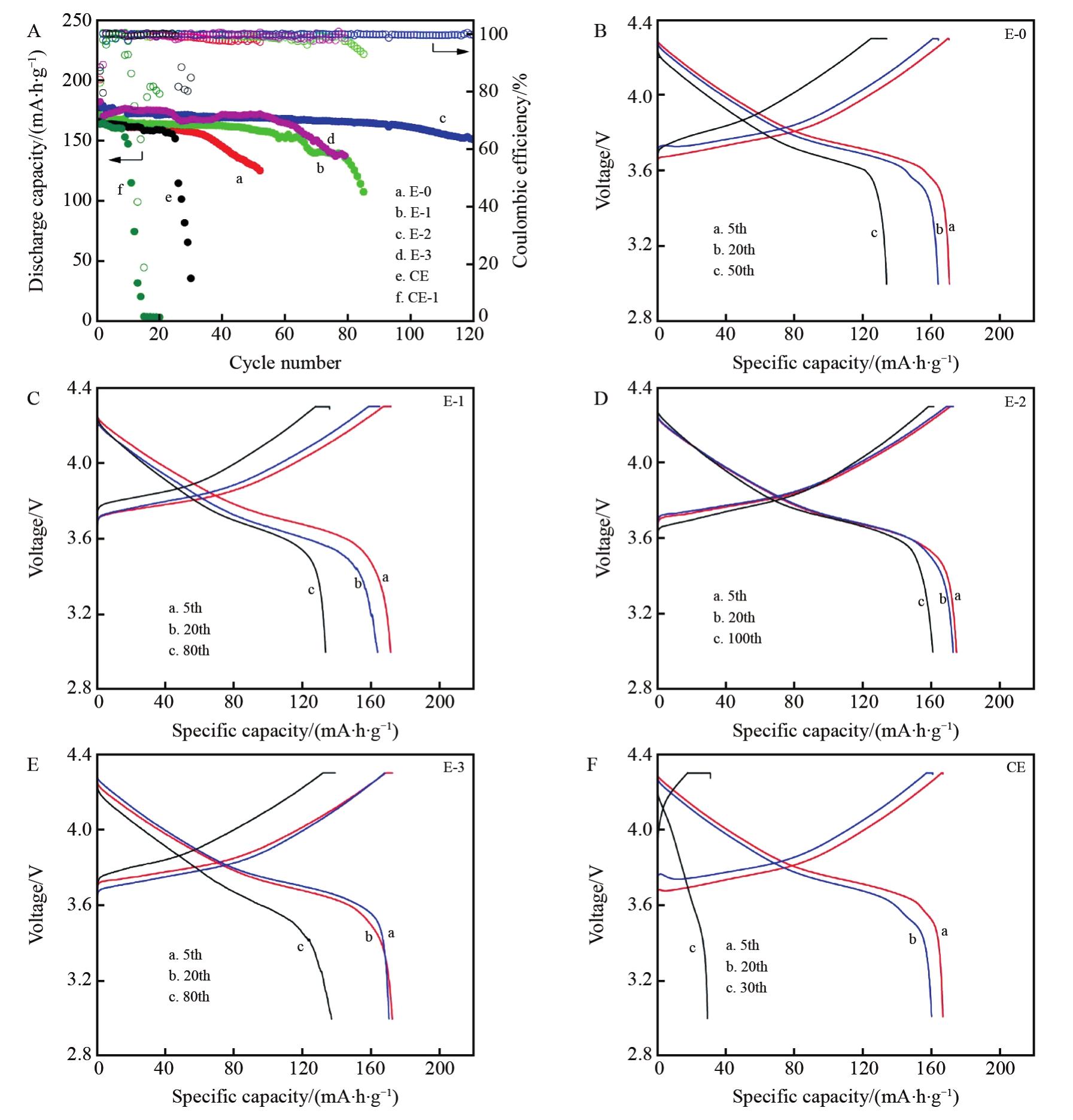
Fig.2 Cycling performance of NCM622/Li cells in different electrolytes(A)and voltage profiles of NCM622/Li cell in E-0(B),E-1(C),E-2(D),E-3(E)and CE(F)electrolytes
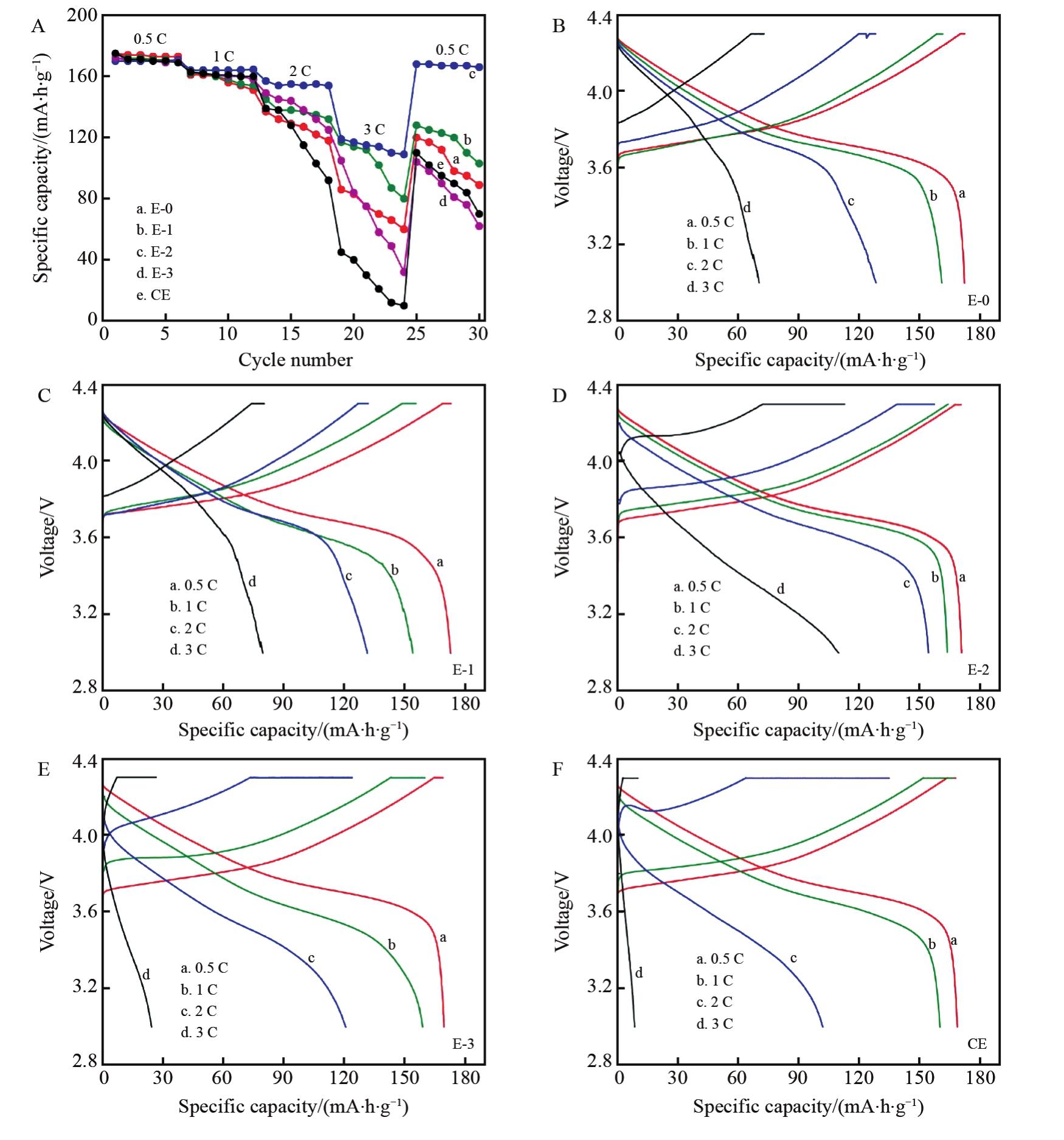
Fig.3 Rate capability of NCM622/Li cells in different electrolytes(A)and rate voltage profiles of NCM622/Li cell in E-0(B),E-1(C),E-2(D),E-3(E)and CE(F)electrolytes
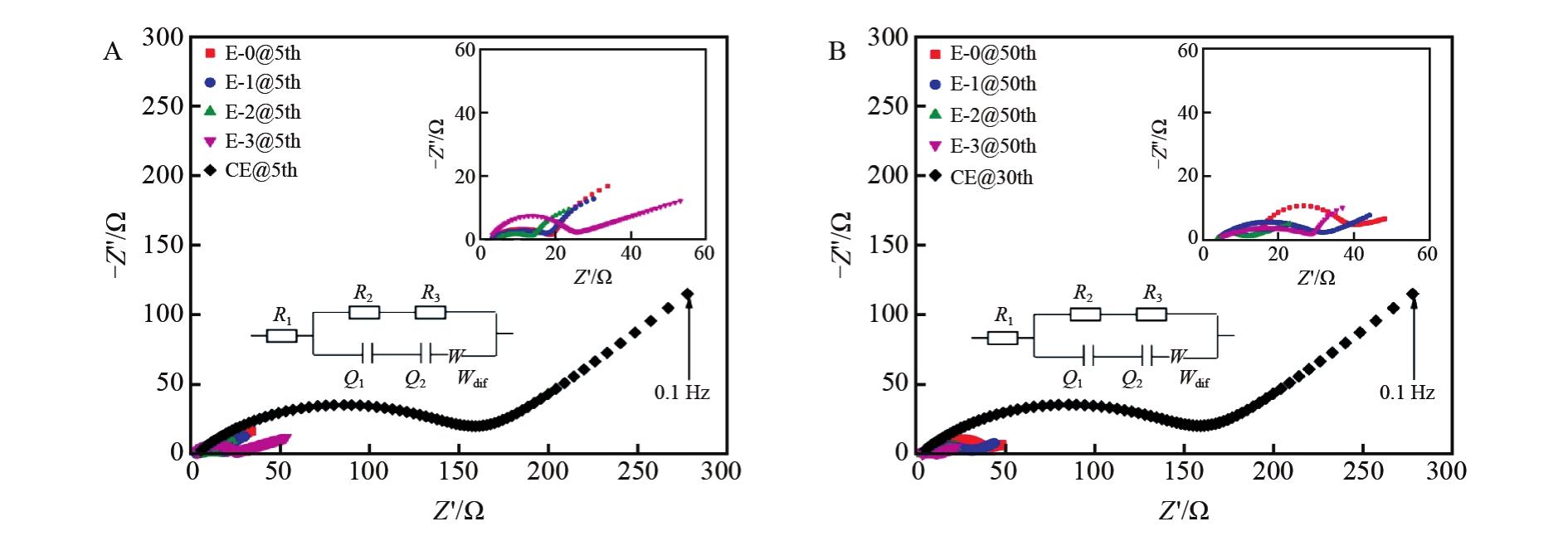
Fig.4 The AC impedance diagram and equivalent circuit diagram of NCM622/Li full cells in different electrolytes at the 5th cycle(A)and 30th or 50th cycle(B)
| 电解液 | 圈数 | 欧姆内阻 | 电荷转移内阻 | 扩散内阻 | 扩散系数 |
|---|---|---|---|---|---|
| Electrolyte | Cycles | Ohmic resistance R1/(Ω·cm2) | Charge transfer resistance R2/(Ω·cm2) | Diffusion resistance/(Ω·cm2) | Diffusion coefficient/(cm2·S-1) |
| E-0 | 5th | 9 | 25 | 37 | 2.8×10-9 |
| ? | 50th | 13 | 28 | 48.5 | 2.3×10-9 |
| E-1 | 5th | 4 | 28 | 32.7 | 2.6×10-9 |
| ? | 50th | 5 | 24 | 44.7 | 2.5×10-9 |
| E-2 | 5th | 5 | 7 | 23.4 | 3.3×10-9 |
| ? | 50th | 3 | 8 | 24.6 | 3.2×10-9 |
| E-3 | 5th | 4 | 23 | 54.6 | 2.5×10-9 |
| ? | 50th | 4.8 | 28 | 37.9 | 2.4×10-9 |
| CE | 5th | 8 | 143 | 299.2 | 1.7×10-9 |
| ? | 30th | 10 | 150 | 304.6 | 1.5×10-9 |
Table 1 Resistance analysis of NCM622/Li cells
| 电解液 | 圈数 | 欧姆内阻 | 电荷转移内阻 | 扩散内阻 | 扩散系数 |
|---|---|---|---|---|---|
| Electrolyte | Cycles | Ohmic resistance R1/(Ω·cm2) | Charge transfer resistance R2/(Ω·cm2) | Diffusion resistance/(Ω·cm2) | Diffusion coefficient/(cm2·S-1) |
| E-0 | 5th | 9 | 25 | 37 | 2.8×10-9 |
| ? | 50th | 13 | 28 | 48.5 | 2.3×10-9 |
| E-1 | 5th | 4 | 28 | 32.7 | 2.6×10-9 |
| ? | 50th | 5 | 24 | 44.7 | 2.5×10-9 |
| E-2 | 5th | 5 | 7 | 23.4 | 3.3×10-9 |
| ? | 50th | 3 | 8 | 24.6 | 3.2×10-9 |
| E-3 | 5th | 4 | 23 | 54.6 | 2.5×10-9 |
| ? | 50th | 4.8 | 28 | 37.9 | 2.4×10-9 |
| CE | 5th | 8 | 143 | 299.2 | 1.7×10-9 |
| ? | 30th | 10 | 150 | 304.6 | 1.5×10-9 |
| [1] | ZHAO Q, TU Z, WEI S, et al. Building organic/inorganic hybridinterphases for fast interfacial transport in rechargeable metal batteries[J]. Angew Chem Int Ed, 2018, 57(4):992-996. |
| [2] | BASILE A, BHATT A I, O′MULLANE A P. Stabilizing lithium metal using ionic liquids for long-lived batteries[J]. Nat Commun, 2016, 7:11794-11805. |
| [3] | SHIM J, KIM H J, KIM B G, et al. 2D boron nitridenanoflakes as a multifunctional additive in gel polymer electrolytes for safe, long cycle life and high rate lithium metal batteries[J]. Energy Environ Sci, 2017, 10:1911-1916. |
| [4] | FAN X, CHEN L, BORODIN O, et al. Non-flammable electrolyte enables Li-metal batteries with aggressive cathode chemistries[J]. Nat Nanotechnol, 2018, 13:715-722. |
| [5] | HU Z, ZHANG S, DONG S, et al. Poly (ethyl α-cyanoacrylate)-based artificial solid electrolyte interphase layer for enhanced interface stability of Li metal anodes[J]. Chem Mater, 2017, 29(11):4682-4689. |
| [6] | CHEN S, ZHENG J, YU L, et al. High-efficiency lithium metalbatteries with fire-retardant electrolytes[J]. Joule, 2018, 2(1):1548-1558. |
| [7] | TONGB, HUANGJ, ZHOUZ. Thesaltmatters: enhancedreversibilityofLi-O2batterieswitha Li[(CF3SO2)(n-C4F9SO2) N]-based electrolyte[J]. Adv Mater, 2018, 30(1):1704841. |
| [8] | CAO Y, LI G T, Li XB. Graphene/layered double hydroxide nano-composite: properties, synthesis, and applications[J]. Chem Eng J, 2016, 292:207-223. |
| [9] | YAN C, CHENG X B, TIAN Y, et al. Dual-layered film protected lithium metal anode to enable dendrite-free lithium deposition[J]. Adv Mater, 2018, 30(25):1707629. |
| [10] | DONG T, ZHANG J, XU G, et al. A multifunctional polymer electrolyte enables ultra-long cycle-life in a high-voltagelithiummetal battery[J]. Energy Environ Sci, 2018, 11:1197-1203. |
| [11] | YANG X Y, FENG X L, JIN X, et al. An illumination-assisted flexible self-powered energy system based on a Li-O2 battery[J]. Angew Chem Int Ed, 2019, 58(46):16411-16415. |
| [12] | YE H, ZHANG Y, YIN Y X, et al. An outlook on low-volume-change lithium metal anodes for long-life batteries[J]. ACS Central Sc, 2020, 6(5):661-671. |
| [13] | LI Z, LIU K, FAN K, et al. Active-oxygen-enhanced homogeneous nucleation of lithium metal onultrathin layered double hydroxide[J]. Angew Chem Int Ed, 2019, 58(12):3962-3966. |
| [14] | 陈果, 刘立炳, 惠怀兵, 等. LiDFOB用于锂离子电池电解液添加剂的性能研究[J]. 电源技术, 2015, 39(7):1387-1389. |
| CHEN G, LIU L B, HUI H B, et al. Research on the performance of LiDFOB used as electrolyte additives for lithium-ion batteries[J]. Power Technol, 2015, 39(7):1387-1389. | |
| [15] | CAO X, XU W, ZHANG J G, et al. Monolithic solid-electrolyteinterphases formed in fluorinated orthoformate-based electrolytes minimize Li depletion and pulverization[J]. Nat Energy, 2019, 4:796-805. |
| [16] | JIAO S H, XU W, ZHANG J G, et al. Behavior of lithium metal anodes under various capacity utilization and high current density in lithium metal batteries[J]. Joule, 2018, 2(1):110-124. |
| [17] | REN X D, XU W, ZHANG J G, et al. Localized high-concentration sulfone electrolytes forhigh-efficiency lithium-metal batteries[J]. Chem, 2018, 4(8):1877-1892. |
| [18] | 张晓研, 任宇飞, 高洁, 等. 动力电池电解液用添加剂的研究进展[J]. 储能科学与技术, 2018, 7(3):404-417. |
| ZHANG X Y, REN Y F, GAO J, et al. Research progress of additives for power battery electrolyte[J]. Energy Stor Sci Technol, 2018, 7(3):404-417. | |
| [19] | 邵俊华, 孔东波, 王亚洲. 成膜添加剂用于高能量密度电池电解液的综述[J]. 电池, 2019, 49(5):440-443. |
| SHAO J H, KONG D B, WANG Y Z. Review of film-forming additives used in high energy density battery electrolyte[J]. Battery, 2019, 49(5):440-443. | |
| [20] | XIE Y, XIANG H, SHI P, et al. Enhanced separatorwettability by LiTFSI and its application for lithium metal batteries[J]. J Membr Sci, 2017, 524(15):315-320. |
| [21] | ZHENG J M, ENGELHARD M H, MEI D H, et al. Electrolyte additive enabled fast charging and stable cycling lithium metal batteries[J]. Nat Energy, 2017, 2(3):17012-17020. |
| [22] | DENG T, FAN X L, CAO L S, et al. Designing in-situ-formed interphases enables highly reversible cobalt-free LiNiO2 cathode for Li-ion and Li-metal batteries[J]. Joule, 2019, 3(10):2550-2564. |
| [23] | DROZHZHIN O A, SHEVCHENKO V A, ZAKHARKIN M V, et al. Improving salt-to-solvent ratio to enable high-voltage electrolyte stability for advanced Li-ion batteries[J]. Electrochim Acta, 2018, 263(10):127-133. |
| [24] | XU M Q, HAO L S, LIU Y L, et al. Experimental and theoretica investigations of dimethylacetamide (DMAc) as electrolyte stabilizing additive for lithium ion batteries[J]. J Phys Chem C, 2011, 115(13):6085-6095. |
| [25] | WANG X S, ZHENG X W, LIAO Y H, et al. Maintaining structural integrity of 4.5 V lithium cobalt oxide cathode with fumaronitrile as a novel electrolyte additive[J]. J Power Sources, 2016, 338(15):108-116. |
| [26] | XU G J, PANG C G, CHEN B B, et al. Prescribing functional additives for treating the poor performances of high-voltage (5 V-class) LiNi0.5Mn1.5O4/MCMB Li-ionbatteries[J]. Adv Energy Mater, 2017, 8(9):1701398. |
| [1] | Dan WANG, Xian-Biao HOU, Xing-Kun WANG, Zhi-Cheng LIU, Huan-Lei WANG, Ming-Hua HUANG. Research Progress of Carbon‑Encapsulated Iron‑Based Nanoparticles Electrocatalysts for Zinc‑Air Batteries [J]. Chinese Journal of Applied Chemistry, 2022, 39(10): 1488-1500. |
| [2] | En-Tong WANG, Lin-Fang YANG. Preparation and Properties of LiNi0.6Co0.2Mn0.2O2 Cathode Material for High Specific Capacity Lithium Ion Battery [J]. Chinese Journal of Applied Chemistry, 2022, 39(8): 1209-1215. |
| [3] | Yan WANG, Shu-Cong ZHANG, Xing-Kun WANG, Zhi-Cheng LIU, Huan-Lei WANG, Ming-Hua HUANG. Research Progress on Transition Metal⁃Based Catalysts for Hydrogen Evolution Reaction via Seawater Electrolysis [J]. Chinese Journal of Applied Chemistry, 2022, 39(6): 927-940. |
| [4] | WANG Shuai1, CHEN Buming1,2*, GUO Zhongcheng1,2, ZHOU Songbing1, YANG Haitao1. Electrochemical Performances of Electrodeposited Al/Pb-Ag Anode in Sulfuric Acid [J]. Chinese Journal of Applied Chemistry, 2014, 31(09): 1101-1106. |
| [5] | PENG Xinhong, YU Hongbing*, WANG Xin. Effect of Nano Fe3O4 Content on the Performance in Microbial Fuel Cell [J]. Chinese Journal of Applied Chemistry, 2013, 30(07): 808-814. |
| [6] | ZHANG Yongchun1, CHEN Buming1, GUO Zhongcheng1,2*, LIU Jianhua1. Corrosion Resistance of Electrodeposited Al/Pb-Ag Anode During Zinc Electrowinning [J]. Chinese Journal of Applied Chemistry, 2013, 30(04): 458-463. |
| [7] | TIAN Mei1,2*, WANG Jing2, YANG Lijuan1, ZHANG Xiaoxue2. Electrocatalytic Degradation of p-Nitrophenol Affected by the Synergsic Effect of Cathode and Anode [J]. Chinese Journal of Applied Chemistry, 2012, 29(11): 1286-1290. |
| [8] | LIANG Guangchao, HUANG Ziyang*, ZHANG Lan, WU Chengbin. Electrochemical Reduction Behavior of Benzoic Acid on Hydrophobic Composite Electrodes [J]. Chinese Journal of Applied Chemistry, 2012, 29(07): 830-835. |
| [9] | YANG Gaixiu1, KONG Xiaoying1, SUN Yongming1*, LI Lianhua1, YUAN Zhenhong1, LU Tianhong2. Progress of Abiotic Cathode Catalysts for Microbial Fuel Cells [J]. Chinese Journal of Applied Chemistry, 2012, 29(02): 123-128. |
| [10] | YANG Zhiyu, HU Meng, JI Xiaodan, LEI Lixu*. The Charge and Discharge Properties and the Optimum Formulation of a Positive Electrode of Nickel Metal Hydride Batteries [J]. Chinese Journal of Applied Chemistry, 2011, 28(11): 1323-1330. |
| [11] | YAO Chenzhong1*, MA Huixuan1, TONG Yexiang2. Electrochemical Preparation and Magnetic Study of Amorphous Nanostructural Nd-Fe-Co-Ni-Mn High Entropy Alloy Film [J]. Chinese Journal of Applied Chemistry, 2011, 28(10): 1189-1194. |
| [12] | LIU Yutang*, PAN Kexue, LIU Chengbin. Preparation of Poly(anthranilic acid)-Copper Particles Modified Electrode and Its Electrochemical Preparation of Poly(anthranilic acid)-Copper Composite Modified Electrode and Its Electrochemical Properties [J]. Chinese Journal of Applied Chemistry, 2011, 28(09): 1052-1057. |
| [13] | WANG Hong1*, YANG Ci1, GUO Chuntai2, WANG Daxing3, SUN Lian3. The Electrochemical Performance Studies on Novel LiFeBO3 Cathode Materials for Li-ion Batteries [J]. Chinese Journal of Applied Chemistry, 2011, 28(07): 821-825. |
| [14] | LU Qiang1, AN Lichao1*, ZHONG Qin1, HU Yue1, XIA Wenwen2, WANG Zhiliang3. Degradation of Nitrobenzene Wastewater by Electrocatalytic Oxidation with Ru0.7Si0.3O2/Ti Electrode [J]. Chinese Journal of Applied Chemistry, 2011, 28(05): 576-582. |
| [15] | LI Xiaoping1,2, LU Haiyan2,3*, REN Xiubin2, LI Wei2, DAN Yuanyuan2, LIN Haibo2,3. Preparation and Performances of PbO2 Electrodes Doped with Fe or Co by the Electro-codeposition Method [J]. Chinese Journal of Applied Chemistry, 2011, 28(05): 571-575. |
| Viewed | ||||||||||||||||||||||||||||||||||||||||||||||||||
|
Full text 373
|
|
|||||||||||||||||||||||||||||||||||||||||||||||||
|
Abstract 612
|
|
|||||||||||||||||||||||||||||||||||||||||||||||||
